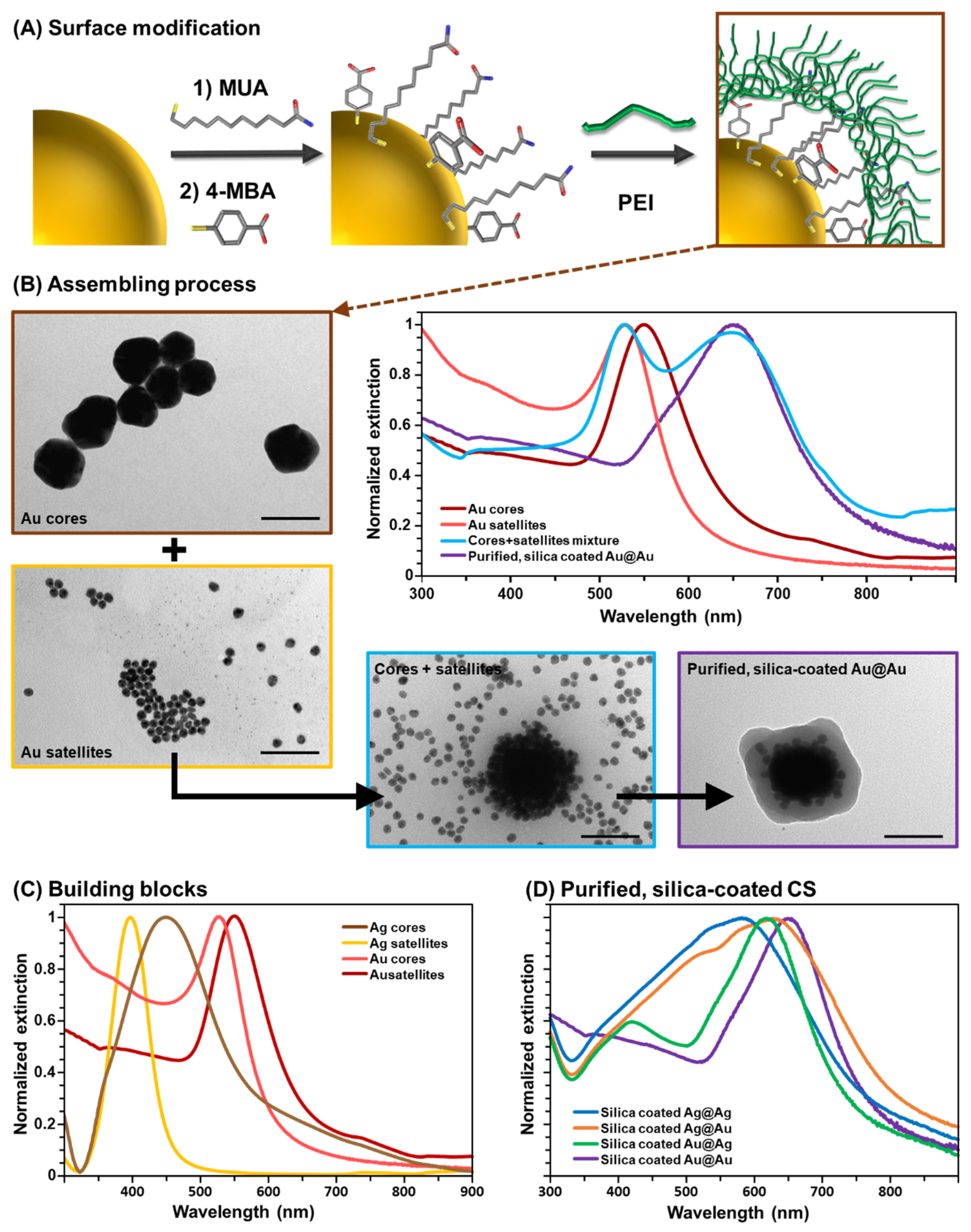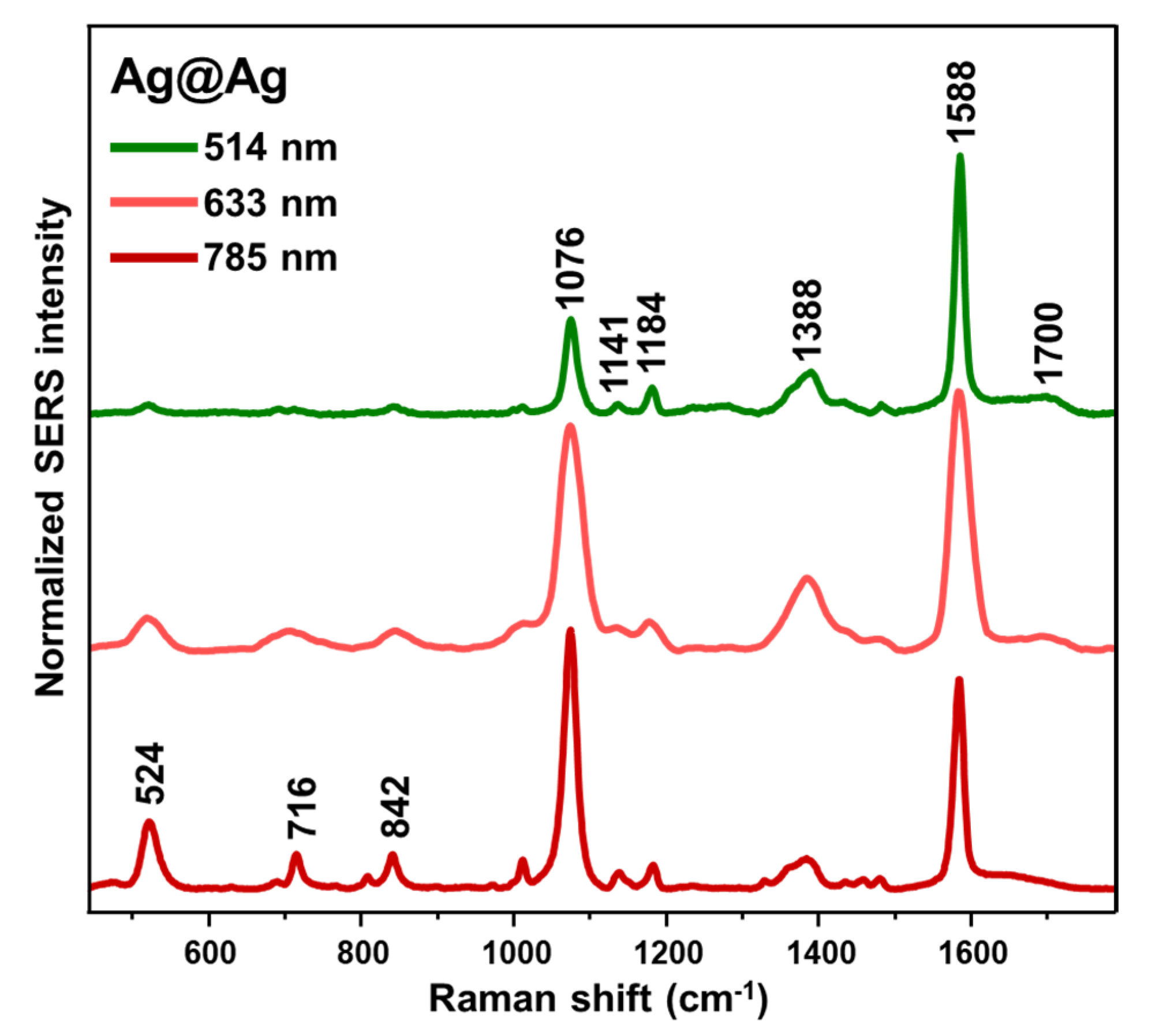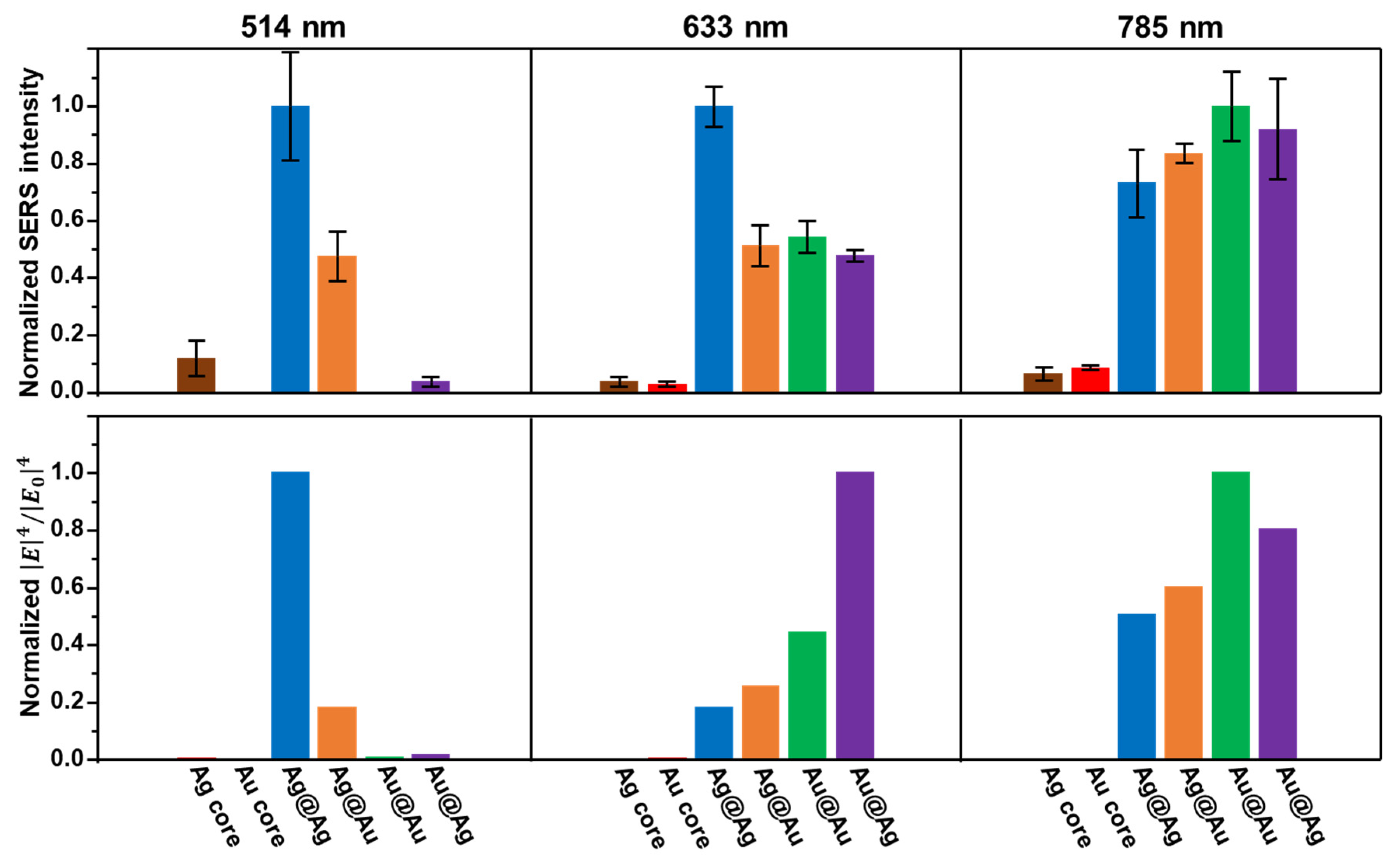Comparative SERS Activity of Homometallic and Bimetallic Core–Satellite Assemblies
Abstract
1. Introduction
2. Materials and Methods
2.1. Materials
2.2. Synthesis of Ag Nanoparticle Cores
2.2.1. Synthesis of Citrate-Capped Silver Nanoparticle Seeds of ~50 nm Diameter
2.2.2. Synthesis of Citrate-Capped Silver Nanoparticle Cores of ~90 nm Diameter
2.3. Synthesis of Au Nanoparticle Cores
2.3.1. Synthesis of Citrate-Capped Gold Nanoparticle Seeds of ~13 nm Diameter
2.3.2. Synthesis of Citrate-Capped Gold Nanoparticle Cores of ~90 nm Diameter
2.4. Synthesis of Au and Ag Nanoparticle Satellites
2.4.1. Synthesis of Citrate-Capped Ag Nanoparticle Satellites
2.4.2. Synthesis of Citrate-Capped Au Nanoparticle Satellites
2.5. Ag and Au Cores Codification and PEI Wrapping
2.5.1. Ag and Au Cores Codification
2.5.2. PEI Wrapping of Ag and Au Cores
2.6. Formation of Core–Satellite Assemblies
2.7. Silica Encapsulation and Purification
2.8. Core–Satellite Samples for SERS Analysis
2.9. Instrumentation
2.10. Numerical Simulations
3. Results
4. Conclusions
Supplementary Materials
Author Contributions
Funding
Data Availability Statement
Acknowledgments
Conflicts of Interest
References
- Lee, S.; Sim, K.; Moon, S.Y.; Choi, J.; Jeon, Y.; Nam, J.; Park, S. Controlled Assembly of Plasmonic Nanoparticles: From Static to Dynamic Nanostructures. Adv. Mater. 2021, 33, 2007668. [Google Scholar] [CrossRef] [PubMed]
- Giannini, V.; Fernandez-Dominguez, A.I.; Sonnefraud, Y.; Roschuk, T.; Fernandez-Garcia, R.; Maier, S.A. Controlling Light Localization and Light-Matter Interactions with Nanoplasmonics. Small 2010, 6, 2498–2507. [Google Scholar] [CrossRef] [PubMed]
- Grzelczak, M.; Liz-Marzán, L.M.; Klajn, R. Stimuli-Responsive Self-Assembly of Nanoparticles. Chem. Soc. Rev. 2019, 48, 1342–1361. [Google Scholar] [CrossRef]
- Ha, M.; Kim, J.H.; You, M.; Li, Q.; Fan, C.; Nam, J.M. Multicomponent Plasmonic Nanoparticles: From Heterostructured Nanoparticles to Colloidal Composite Nanostructures. Chem. Rev. 2019, 119, 12208–12278. [Google Scholar] [CrossRef]
- Klinkova, A.; Choueiri, R.M.; Kumacheva, E. Self-Assembled Plasmonic Nanostructures. Chem. Soc. Rev. 2014, 43, 3976–3991. [Google Scholar] [CrossRef]
- Seo, S.; Zhou, X.; Liu, G.L. Sensitivity Tuning through Additive Heterogeneous Plasmon Coupling between 3D Assembled Plasmonic Nanoparticle and Nanocup Arrays. Small 2016, 12, 3453–3462. [Google Scholar] [CrossRef]
- Liu, G.; Liu, Y.; Tang, L.; Liu, X.; Fu, G.; Liu, Z. Semiconductor-Enhanced Raman Scattering Sensors via Quasi-Three-Dimensional Au/Si/Au Structures. Nanophotonics 2019, 8, 1095–1107. [Google Scholar] [CrossRef]
- Tan, S.J.; Campolongo, M.J.; Luo, D.; Cheng, W.L. Building Plasmonic Nanostructures with DNA. Nat. Nanotechnol. 2011, 6, 268–276. [Google Scholar] [CrossRef]
- Gu, Q.; Zhu, J.; Weng, G.-J.; Li, J.-J.; Zhao, J.-W. Core-Satellite Nanostructures and Their Biomedical Applications. Microchim. Acta 2022, 189, 470. [Google Scholar] [CrossRef]
- Schlücker, S. Surface-Enhanced Raman Spectroscopy: Concepts and Chemical Applications. Angew. Chem. Int. Ed. 2014, 53, 4756–4795. [Google Scholar] [CrossRef]
- Le Ru, E.C.; Etchegoin, P.G. Principles of Surface-Enhanced Raman Spectroscopy; Elsevier: Amsterdam, The Netherlands, 2009; ISBN 9780444527790. [Google Scholar]
- Etchegoin, P.G.; Le Ru, E.C. A Perspective on Single Molecule SERS: Current Status and Future Challenges. Phys. Chem. Chem. Phys. 2008, 10, 6079–6089. [Google Scholar] [CrossRef] [PubMed]
- Pazos-Perez, N.; Guerrini, L. Extending the Range of Metal Ions SERS Detection Using Hybrid Plasmonic/ZIF-8 Particles. Talanta 2023, 266, 124941. [Google Scholar] [CrossRef] [PubMed]
- Langer, J.; Jimenez de Aberasturi, D.; Aizpurua, J.; Alvarez-Puebla, R.A.; Auguié, B.; Baumberg, J.J.; Bazan, G.C.; Bell, S.E.J.; Boisen, A.; Brolo, A.G.; et al. Present and Future of Surface-Enhanced Raman Scattering. ACS Nano 2020, 14, 28–117. [Google Scholar] [CrossRef]
- Das, G.M.; Managò, S.; Mangini, M.; De Luca, A.C. Biosensing Using SERS Active Gold Nanostructures. Nanomaterials 2021, 11, 2679. [Google Scholar] [CrossRef] [PubMed]
- Plou, J.; Valera, P.S.; García, I.; De Albuquerque, C.D.L.; Carracedo, A.; Liz-Marzán, L.M. Prospects of Surface-Enhanced Raman Spectroscopy for Biomarker Monitoring toward Precision Medicine. ACS Photonics 2022, 9, 333–350. [Google Scholar] [CrossRef]
- Rossner, C.; Vana, P. Planet-Satellite Nanostructures Made to Order by Raft Star Polymers. Angew. Chem.-Int. Ed. 2014, 53, 12639–12642. [Google Scholar] [CrossRef]
- Pazos-Perez, N.; Fitzgerald, J.M.; Giannini, V.; Guerrini, L.; Alvarez-Puebla, R.A. Modular Assembly of Plasmonic Core-Satellite Structures as Highly Brilliant SERS-Encoded Nanoparticles. Nanoscale Adv. 2019, 1, 122–131. [Google Scholar] [CrossRef]
- Jancke, S.; Liu, C.; Wang, R.; Sarkar, S.; Besford, Q.A.; König, T.A.F.; Popp, J.; Cialla-May, D.; Rossner, C. Turning on Hotspots: Supracolloidal SERS Probes Made Brilliant by an External Activation Mechanism. Nanoscale 2023, 15, 18687–18695. [Google Scholar] [CrossRef]
- Shiohara, A.; Novikov, S.M.; Solís, D.M.; Taboada, J.M.; Obelleiro, F.; Liz-Marzán, L.M. Plasmon Modes and Hot Spots in Gold Nanostar–Satellite Clusters. J. Phys. Chem. C 2015, 119, 10836–10843. [Google Scholar] [CrossRef]
- Ruan, Q.; Shao, L.; Shu, Y.; Wang, J.; Wu, H. Growth of Monodisperse Gold Nanospheres with Diameters from 20 Nm to 220 Nm and Their Core/Satellite Nanostructures. Adv. Opt. Mater. 2014, 2, 65–73. [Google Scholar] [CrossRef]
- Wang, Y.Q.; Yan, B.; Chen, L.X. SERS Tags: Novel Optical Nanoprobes for Bioanalysis. Chem. Rev. 2013, 113, 1391–1428. [Google Scholar] [CrossRef] [PubMed]
- Cho, E.C.; Au, L.; Zhang, Q.; Xia, Y. The Effects of Size, Shape, and Surface Functional Group of Gold Nanostructures on Their Adsorption and Internalization by Cells. Small 2010, 6, 517–522. [Google Scholar] [CrossRef]
- Amirjani, A.; Amlashi, N.B.; Ahmadiani, Z.S. Plasmon-Enhanced Photocatalysis Based on Plasmonic Nanoparticles for Energy and Environmental Solutions: A Review. ACS Appl. Nano Mater. 2023, 6, 9085–9123. [Google Scholar] [CrossRef]
- Tian, L.; Wang, C.; Zhao, H.; Sun, F.; Dong, H.; Feng, K.; Wang, P.; He, G.; Li, G. Rational Approach to Plasmonic Dimers with Controlled Gap Distance, Symmetry, and Capability of Precisely Hosting Guest Molecules in Hotspot Regions. J. Am. Chem. Soc. 2021, 143, 8631–8638. [Google Scholar] [CrossRef] [PubMed]
- Weller, L.; Thacker, V.V.; Herrmann, L.O.; Hemmig, E.A.; Lombardi, A.; Keyser, U.F.; Baumberg, J.J. Gap-Dependent Coupling of Ag-Au Nanoparticle Heterodimers Using DNA Origami-Based Self-Assembly. ACS Photonics 2016, 3, 1589–1595. [Google Scholar] [CrossRef]
- Bastús, N.G.; Merkoçi, F.; Piella, J.; Puntes, V. Synthesis of Highly Monodisperse Citrate-Stabilized Silver Nanoparticles of up to 200 Nm: Kinetic Control and Catalytic Properties. Chem. Mater. 2014, 26, 2836–2846. [Google Scholar] [CrossRef]
- Bastus, N.G.; Comenge, J.; Puntes, V. Kinetically Controlled Seeded Growth Synthesis of Citrate-Stabilized Gold Nanoparticles of up to 200 Nm: Size Focusing versus Ostwald Ripening. Langmuir 2011, 27, 11098–11105. [Google Scholar] [CrossRef]
- Blanco-Formoso, M.; Turino, M.; Rivas-Murias, B.; Guerrini, L.; Shavel, A.; De La Rica, R.; Correa-Duarte, M.; Salgueiriño, V.; Pazos-Perez, N.; Alvarez-Puebla, R.A. Iron-Assisted Synthesis of Highly Monodispersed and Magnetic Citrate-Stabilized Small Silver Nanoparticles. J. Phys. Chem. C 2020, 124, 3270–3276. [Google Scholar] [CrossRef]
- Enustun, B.V.; Turkevich, J. Coagulation of Colloidal Gold. J. Am. Chem. Soc. 1963, 85, 3317–3328. [Google Scholar] [CrossRef]
- Mir-Simon, B.; Reche-Perez, I.; Guerrini, L.; Pazos-Perez, N.; Alvarez-Puebla, R. Universal One-Pot and Scalable Synthesis of SERS Encoded Nanoparticles. Chem. Mater. 2015, 27, 950–958. [Google Scholar] [CrossRef]
- Stöber, W.; Fink, A.; Bohn, E. Controlled Growth of Monodisperse Silica Spheres in Micron Size Range. J. Colloid Interface Sci. 1968, 26, 62–69. [Google Scholar] [CrossRef]
- Paramelle, D.; Sadovoy, A.; Gorelik, S.; Free, P.; Hobley, J.; Fernig, D.G. A Rapid Method to Estimate the Concentration of Citrate Capped Silver Nanoparticles from UV-Visible Light Spectra. Analyst 2014, 139, 4855–4861. [Google Scholar] [CrossRef] [PubMed]
- Hagemann, H.-J.; Gudat, W.; Kunz, C. Optical Constants from the Far Infrared to the X-Ray Region: Mg, Al, Cu, Ag, Au, Bi, C, and Al2O3. J. Opt. Soc. Am. 1975, 65, 742. [Google Scholar] [CrossRef]
- Johnson, P.B.; Christy, R.W. Optical Constants of the Noble Metals. Phys. Rev. B 1972, 6, 4370–4379. [Google Scholar] [CrossRef]
- Trinh, H.D.; Kim, S.; Park, J.; Yoon, S. Core–Satellite–Satellite Hierarchical Nanostructures: Assembly, Plasmon Coupling, and Gap-Selective Surface-Enhanced Raman Scattering. Nanoscale 2022, 14, 17003–17012. [Google Scholar] [CrossRef]
- Jain, P.K.; Lee, K.S.; El-Sayed, I.H.; El-Sayed, M.A. Calculated Absorption and Scattering Properties of Gold Nanoparticles of Different Size, Shape, and Composition: Applications in Biological Imaging and Biomedicine. J. Phys. Chem. B 2006, 110, 7238–7248. [Google Scholar] [CrossRef]
- Guerrini, L.; Alvarez-Puebla, R.A.; Pazos-Perez, N. Surface Modifications of Nanoparticles for Stability in Biological Fluids. Materials 2018, 11, 1154. [Google Scholar] [CrossRef]
- Alvarez-Puebla, R.A. Effects of the Excitation Wavelength on the SERS Spectrum. J. Phys. Chem. Lett. 2012, 3, 857–866. [Google Scholar] [CrossRef]
- Michota, A.; Bukowska, J. Surface-Enhanced Raman Scattering (SERS) of 4-Mercaptobenzoic Acid on Silver and Gold Substrates. J. Raman Spectrosc. 2003, 34, 21–25. [Google Scholar] [CrossRef]
- Ma, W.Q.; Fang, Y.; Hao, G.L.; Wang, W.G. Adsorption Behaviors of 4-Mercaptobenzoic Acid on Silver and Gold Films. Chin. J. Chem. Phys. 2010, 23, 659–663. [Google Scholar] [CrossRef]
- Bishnoi, S.W.; Rozell, C.J.; Levin, C.S.; Gheith, M.K.; Johnson, B.R.; Johnson, D.H.; Halas, N.J. All-Optical Nanoscale PH Meter. Nano Lett. 2006, 6, 1687–1692. [Google Scholar] [CrossRef] [PubMed]
- Lee, S.J.; Moskovits, M. Visualizing Chromatographic Separation of Metal Ions on a Surface-Enhanced Raman Active Medium. Nano Lett. 2011, 11, 145–150. [Google Scholar] [CrossRef] [PubMed]
- Le Ru, E.C.; Etchegoin, P.G.; Meyer, M. Enhancement Factor Distribution around a Single Surface-Enhanced Raman Scattering Hot Spot and Its Relation to Single Molecule Detection. J. Chem. Phys. 2006, 125, 204701–204713. [Google Scholar] [CrossRef] [PubMed]
- Le Ru, E.C.; Etchegoin, P.G. Rigorous Justification of the E(4) Enhancement Factor in Surface Enhanced Raman Spectroscopy. Chem. Phys. Lett. 2006, 423, 63–66. [Google Scholar] [CrossRef]




Disclaimer/Publisher’s Note: The statements, opinions and data contained in all publications are solely those of the individual author(s) and contributor(s) and not of MDPI and/or the editor(s). MDPI and/or the editor(s) disclaim responsibility for any injury to people or property resulting from any ideas, methods, instructions or products referred to in the content. |
© 2024 by the authors. Licensee MDPI, Basel, Switzerland. This article is an open access article distributed under the terms and conditions of the Creative Commons Attribution (CC BY) license (https://creativecommons.org/licenses/by/4.0/).
Share and Cite
Terrones-Morey, G.; Xiao, X.; Giannini, V.; Fragoso, A.; Guerrini, L.; Pazos-Perez, N. Comparative SERS Activity of Homometallic and Bimetallic Core–Satellite Assemblies. Nanomaterials 2024, 14, 1506. https://doi.org/10.3390/nano14181506
Terrones-Morey G, Xiao X, Giannini V, Fragoso A, Guerrini L, Pazos-Perez N. Comparative SERS Activity of Homometallic and Bimetallic Core–Satellite Assemblies. Nanomaterials. 2024; 14(18):1506. https://doi.org/10.3390/nano14181506
Chicago/Turabian StyleTerrones-Morey, Gianfranco, Xiaofei Xiao, Vincenzo Giannini, Alex Fragoso, Luca Guerrini, and Nicolas Pazos-Perez. 2024. "Comparative SERS Activity of Homometallic and Bimetallic Core–Satellite Assemblies" Nanomaterials 14, no. 18: 1506. https://doi.org/10.3390/nano14181506
APA StyleTerrones-Morey, G., Xiao, X., Giannini, V., Fragoso, A., Guerrini, L., & Pazos-Perez, N. (2024). Comparative SERS Activity of Homometallic and Bimetallic Core–Satellite Assemblies. Nanomaterials, 14(18), 1506. https://doi.org/10.3390/nano14181506






